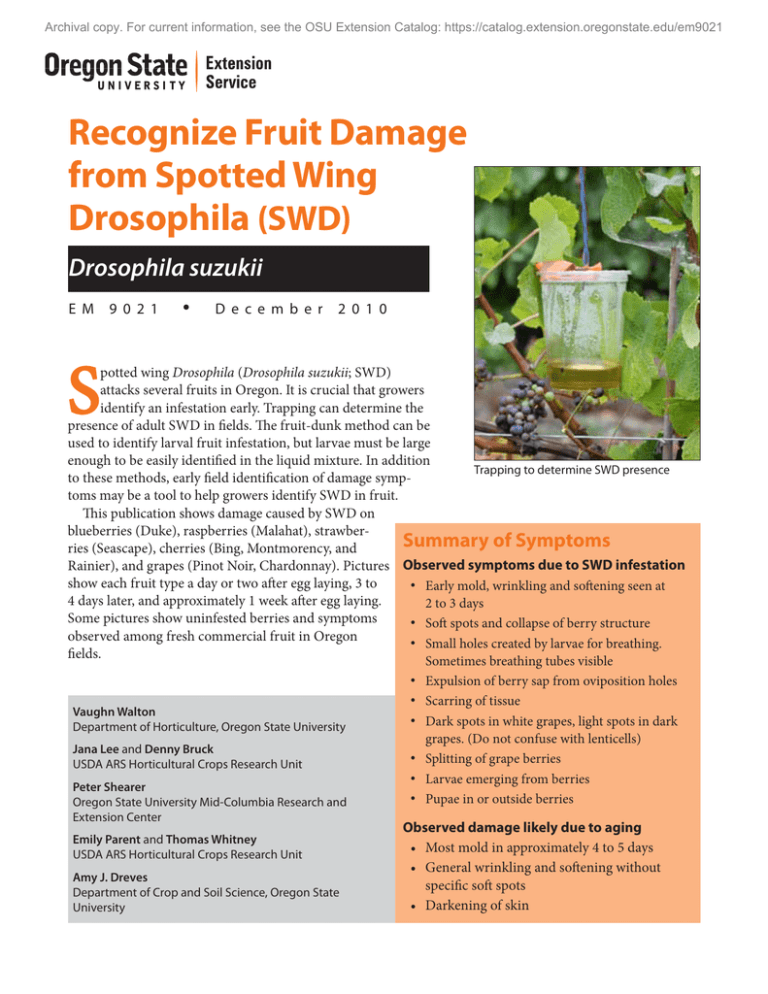Recognize Fruit Damage from Spotted Wing Drosophila (Drosophila
advertisement

Archival copy. For current information, see the OSU Extension Catalog: https://catalog.extension.oregonstate.edu/em9021 Recognize Fruit Damage from Spotted Wing Drosophila (SWD) Drosophila suzukii EM 9021 • D e ce m b e r 2 0 1 0 S potted wing Drosophila (Drosophila suzukii; SWD) attacks several fruits in Oregon. It is crucial that growers identify an infestation early. Trapping can determine the presence of adult SWD in fields. The fruit-dunk method can be used to identify larval fruit infestation, but larvae must be large enough to be easily identified in the liquid mixture. In addition Trapping to determine SWD presence to these methods, early field identification of damage symptoms may be a tool to help growers identify SWD in fruit. This publication shows damage caused by SWD on blueberries (Duke), raspberries (Malahat), strawberSummary of Symptoms ries (Seascape), cherries (Bing, Montmorency, and Rainier), and grapes (Pinot Noir, Chardonnay). Pictures Observed symptoms due to SWD infestation show each fruit type a day or two after egg laying, 3 to • Early mold, wrinkling and softening seen at 4 days later, and approximately 1 week after egg laying. 2 to 3 days Some pictures show uninfested berries and symptoms • Soft spots and collapse of berry structure observed among fresh commercial fruit in Oregon • Small holes created by larvae for breathing. fields. Sometimes breathing tubes visible • Expulsion of berry sap from oviposition holes • Scarring of tissue Vaughn Walton • Dark spots in white grapes, light spots in dark Department of Horticulture, Oregon State University grapes. (Do not confuse with lenticells) Jana Lee and Denny Bruck • Splitting of grape berries USDA ARS Horticultural Crops Research Unit • Larvae emerging from berries Peter Shearer • Pupae in or outside berries Oregon State University Mid-Columbia Research and Extension Center Emily Parent and Thomas Whitney USDA ARS Horticultural Crops Research Unit Amy J. Dreves Department of Crop and Soil Science, Oregon State University Observed damage likely due to aging • Most mold in approximately 4 to 5 days • General wrinkling and softening without specific soft spots • Darkening of skin Archival copy. For current information, see the OSU Extension Catalog: https://catalog.extension.oregonstate.edu/em9021 Recognize fruit damage from spotted wing Drosophila (SWD) Strawberries 3–days after egg laying Egg laying More than 5 days after egg laying Infested fruit Oblong egg under the surface Quick deterioration. The skin wrinkles and fruit softens; mold may appear ~3 days after infestation. Uninfested fruit Uninfested strawberries may stay firm with minimal damage. Raspberries 3–4 days after egg laying More than 5 days after egg laying Raspberries show damage quickly. The skin wrinkles and fruit becomes juicy. Scarring and collapse of berry may occur as soon as 1–2 days following infestation. Dark scarring apparent Egg laying Breathing tube Infested fruit Uninfested fruit Uninfested raspberries may show mild overall softening. 2 Archival copy. For current information, see the OSU Extension Catalog: https://catalog.extension.oregonstate.edu/em9021 Recognize fruit damage from spotted wing Drosophila (SWD) Cherries More than 5 days after egg laying Egg laying Breathing tubes visible under 30X magnification Collapsed berries with pupae on surface (arrow) Emerging prepupal stages and damage directly under the cherry surface Oviposition holes often associated with black necrotic scar tissue Blueberries 3–4 days after egg laying Egg laying More than 5 days after egg laying Infested fruit Blueberries start to show visible damage ~3 days following infes­ tation. Larval holes allow fruit juice to escape the berry, and soft areas become pronounced. Larvae may be visible when suspect fruit are split open. Collapsed fruit Pupae may be found in fruit. Uninfested fruit Uninfested blueberries can remain firm up to 6 or 7 days. By day 3, mild wrinkling may occur. 3 Archival copy. For current information, see the OSU Extension Catalog: https://catalog.extension.oregonstate.edu/em9021 Recognize fruit damage from spotted wing Drosophila (SWD) Grapes 3–4 days after egg laying Egg laying Dark area in light fruit Infested fruit Light area in darker fruit More than 5 days after egg laying Berry splitting due to Botrytis. SWD lays eggs in the split areas. Larvae may be visible when suspect fruit are split open. Field-infested fruit Oviposition in damaged areas, where the pedicel has detached Infested berries where turgor pressure caused expulsion of liquid through oviposition hole Emerging larvae and collapsing berries Figures provided in this document are intended as a tool for growers and do not indicate that marketed fruit may contain live SWD. Photos by: Emily Parent and Thomas Whitney, USDA ARS Horticultural Crops Research Unit, Corvallis, OR; Peter Shearer, Oregon State University Mid-Columbia Research and Extension Center; Mike Reitmajer, Daniel Dalton, and Vaughn Walton, Department of Horticulture, Oregon State University. Reprinted with permission. © 2010 Oregon State University. This publication was produced and distributed in furtherance of the Acts of Congress of May 8 and June 30, 1914. Extension work is a cooperative program of Oregon State University, the U.S. Department of Agriculture, and Oregon counties. Oregon State University Extension Service offers educational programs, activities, and materials without discrimination based on age, color, disability, gender identity or expression, marital status, national origin, race, religion, sex, sexual orientation, or veteran’s status. Oregon State University Extension Service is an Equal Opportunity Employer. Published December 2010. 4


